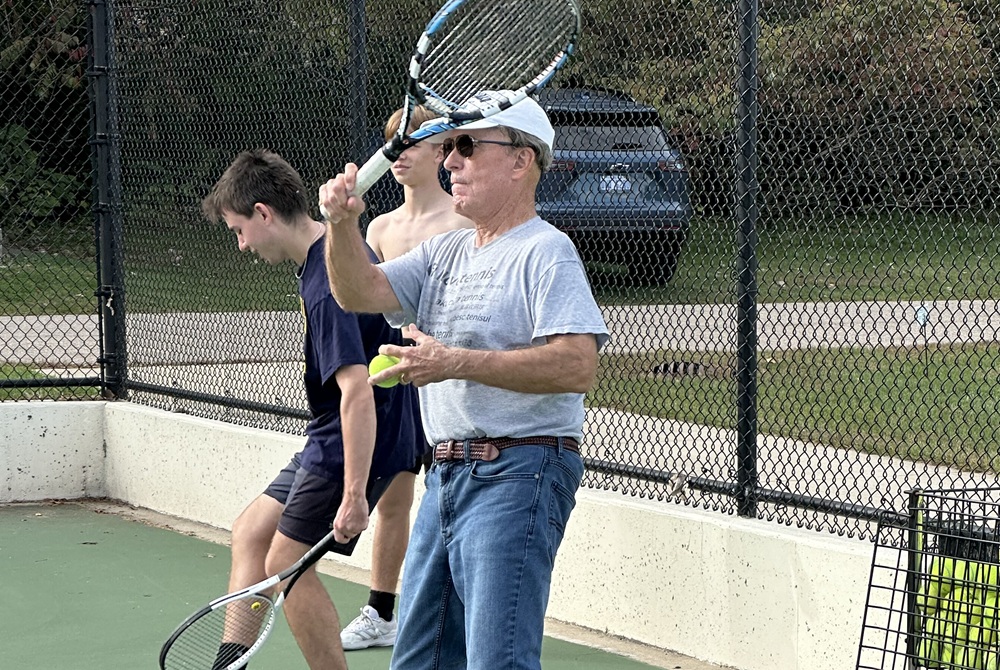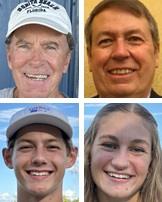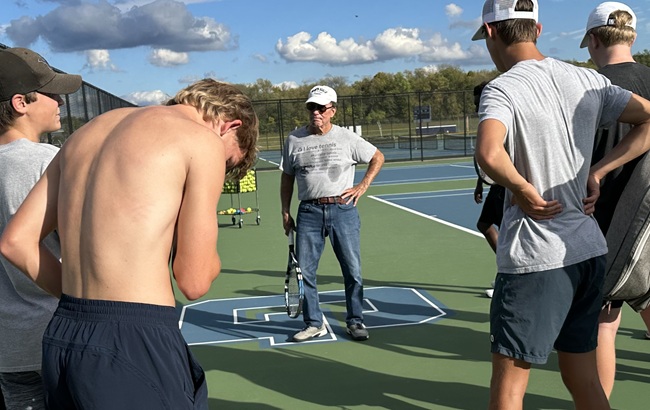
'Hearts' Focus Includes Action Planning
November 12, 2015
By Geoff Kimmerly
Second Half editor
As most of Michigan’s high school athletes move inside this month for the start of winter sports, many will take part in a program introduced to Michigan High School Athletic Association member schools this fall that assists coaches and students in preparing for the possibility of a health emergency during their after-school practices and events.
Prior to the start of this 2015-16 school year, the MHSAA sent every member school the “Anyone Can Save a Life” emergency action plan authored by the Minnesota State High School League and the Medtronic Foundation. The program instructs schools to assemble teams made up of coaches and their students that will act in the event someone suffers sudden cardiac arrest or another emergency medical situation.
“Anyone Can Save a Life” suggests a game plan that establishes four teams on every level of every sport in a school – a 911 Team, CPR (cardiopulmonary resuscitation) Team, AED (automated external defibrillator) Team and Heat Stroke Team. The groups are made up of coaches and their students who will be in close proximity to all after-school activities.
It’s another valuable tool as the MHSAA begins work on the fourth piece of its eight-year “4 H’s” health and safety emphasis. The next two school years focus on Hearts to go with efforts over the last six years centered on Health Histories, Heads and Heat issues faced by MHSAA athletes. This fall, for the first time, all varsity head coaches at MHSAA member schools were required to have CPR certification – another means by which athletic personnel can work to counter the random, unpredictable nature of sudden cardiac arrest.
“There is something we can do. We can be prepared. We can develop emergency plans, display AEDs and deliver CPR. And, like any good sports teams, we need to practice our preparations,” MHSAA Executive Director John E. “Jack” Roberts said. “’Anyone Can Save a Life’ can help schools revise or revitalize their existing emergency plans in ways that engage team members in planning, practice and execution. This could help save lives now and also convey important lifelong life-saving lessons to students involved on these teams.”
Students are a vital component to having a successful emergency action plan. They will be put in position to call 911, meet the ambulance at a pre-determined access point, locate the nearest AED, make sure immersion tubs are filled for hot-weather practices, and for those who are trained, to assist with CPR. Coaches identify students at the beginning of the season and prior to an emergency taking place, and provide them with the details of the job they are assigned so they will be ready to assist in the event of an emergency.
The “Anyone Can Save a Life” plan was sent to schools nationwide with assistance from the National Federation of State High School Associations and the NFHS Foundation. Click for information on "Anyone Can Save a Life."
“The ‘Anyone Can Save a Life’ initiative promotes the need to have and to practice planning for different kinds of emergencies,” Roberts said. “The result can be a fresh, comprehensive emphasis on preparing for emergencies well before they occur and then responding with more confidence when those emergencies inevitably happen. It is the perfect link between the last two years when we focused on heat illness and the next two years when we focus on sudden cardiac arrest.”
This fall’s focus on “Hearts” began in the wake of 122 Michigan schools receiving recognition this spring as HEARTSafe by the Michigan Department of Health and Human Services, Michigan Department of Education, American Heart Association, Michigan Alliance for Prevention of Sudden Cardiac Death of the Young and the MHSAA.
Public Act 12 of 2014 requires all schools (grades kindergarten to 12) to have a cardiac emergency response plan in place. This MI HEARTSafe School designation recognizes 122 schools that have taken steps above and beyond to prepare to respond in the event of a cardiac emergency, and is awarded for a period of three years.
In order for a school to receive MI HEARTSafe designation, it must perform at least one cardiac emergency response drill per year, have a written medical emergency response plan and team, have current CPR/AED certification of at least 10 percent of staff, have accessible, properly maintained and inspected AEDs with signs identifying their location, and ensure pre-participation sports screening of all student-athletes using the current physical and history form endorsed by the MHSAA.
Schools that meet all requirements are able to apply for the MI HEARTSafe School designation each year. Click for information and for a list of designated schools.

Built Right, No Rebuild Needed: Cornelius Taking Gull Lake Back to Tennis Finals
By
Pam Shebest
Special for MHSAA.com
October 21, 2025
RICHLAND – Once the boys season ends later this week, Roger Cornelius will begin preparing for his 50th year as varsity girls tennis coach at Gull Lake High School.
 That tenure may have been cut short at 22 years, if not for the Gull Lake tennis community.
That tenure may have been cut short at 22 years, if not for the Gull Lake tennis community.
In January 1998, Cornelius’ 16-year-old daughter, Lindsay, died as a result of a winter car crash.
He had recently ended the fall season with the girls team and “I didn’t know if I could (coach) the boys that spring,” he said, still emotional when talking about the tragedy.
One of his former students, Jason Ryan, now a vascular surgeon at Beacon Kalamazoo Hospital, contacted Cornelius.
“He and one or two other guys talked with me and, if not for them, I would have quit tennis,” Cornelius said. “I decided to continue with tennis, and I’m glad I did. I found out that God was going to carry me through the toughest time of my life. The tennis community was really big for me back then. Richland, especially, came beside me and lifted me up.”
Although tennis is his sport of choice, Cornelius played football at Western Michigan University and was first hired at Gull Lake in 1975 to help with the football program. He jumped at the chance to coach the tennis team that spring and has coached either the boys or girls, and sometimes both, every year since.
He has been named Regional Coach of the Year several times and was enshrined in the Michigan High School Tennis Coaches Association (MHSTeCA) Hall of Fame in 2018.
Cornelius will lead the boys (12-2-1) to the MHSAA Lower Peninsula Division 3 Finals this Friday and Saturday at Midland Tennis Center. The Blue Devils finished 10th the last two years, earning eight points both times.
In a rebuilding year after losing all four singles and two doubles players to graduation, Cornelius was surprised and thrilled that this year’s team earned 20 points at its Regional, finishing second to St. Joseph and qualifying for the Finals.
At the beginning of the season, senior Peyton Orley said he wasn’t sure how good the team would be.
“Last year at the beginning of the season, we could tell we had a really good team,” Orley said. "This year, we lost a lot of our seniors and it didn’t look promising for states.
“Everyone on the team was mission-motivated to get to the state tournament.”
 Orley pairs with senior Sullivan Abegg at No 1 singles and the pair did their part, winning their Regional flight. For Abegg, it was a three-peat after taking the title at No. 3 doubles two years ago and No. 2 doubles last year.
Orley pairs with senior Sullivan Abegg at No 1 singles and the pair did their part, winning their Regional flight. For Abegg, it was a three-peat after taking the title at No. 3 doubles two years ago and No. 2 doubles last year.
The Blue Devils are led at No. 1 singles by freshman Kade DeMaagd, whose father also played for Cornelius.
“Kade’s got the best strokes on the team,” the coach said.
Lucas Nichols, at No. 4 doubles, is the other freshman in the lineup. The other three seniors are Max Uppal (No 3 singles) and Dylan Piwko and Evan McCann, both doubles players. Three juniors, who all play doubles, are Jaden Jones, Jackson McDermott and McGuire Abegg. Two sophomores round out the singles flights: Jake Worgess at No. 2 and Jacob Nichols at No. 4.
Comparing old & new
Cornelius said there isn’t much difference between the tennis players today compared to those 50 years ago.
“I think what’s changed the most is today’s athletes have so many different options, so many different interest areas,” he said. “A lot of the kids have early college classes, some of them have to come to practice from off site and so many things are happening, whether it’s the Model United Nations or tutoring someone at the high school or DECA. I think that’s the biggest difference.”
While the boys are competing in Division 3, the girls are in Division 2, a more difficult road to the Finals, Cornelius said.
“It does make it pretty tough for the girls to make it out of Division 2 with the Mattawans, Portage Central, St. Joe, Battle Creek Lakeview,” he said.
Orley’s sister, Ava, a junior who plays at No. 1 doubles, said the girls team has already bonded.
“We build our team off loving each other,” she said. “It’s not everyone out for themselves, it’s all of us (working together). We focus on being a good role model.
"We’ve had coaches tell us how we played with class and how it’s an honor to play us because we learned from (Cornelius) that you always want to be a good sport.”
Competitive, compassionate
Cornelius, who taught French at the high school for 32 years, currently tutors French-speaking African and Haitian families for the district.
“I tutor the kids and work with the families,” he said. “It’s vastly different than what I did in the classroom. The greatest thing that’s ever happened to me in my nearly 50 years working with Gull Lake schools was working with a little African boy who was blind.”
Cornelius and some friends pooled money to take the boy to a specialist in Grand Rapids. The specialist asked Cornelius to translate for the mother that he thought he could help the young boy regain some sight.
“The two surgeries were successful,” said Cornelius, choking up a bit with emotion. "He has to wear glasses, but he can see. It’s the high watermark of my life.”
That compassion is visible on the tennis courts, said retired Allegan coach Gary Ellis, now a volunteer assistant tennis coach at the school.
 “I’ve known Roger since 1977,” Ellis said. “We started competing against each other when he started coaching the boys.”
“I’ve known Roger since 1977,” Ellis said. “We started competing against each other when he started coaching the boys.”
He said that although Cornelius wants to win and likes to compete, “at the same time, he’s got a good perspective on the whole thing and the value of high school sports, and tennis in particular. He’s very positive, both with his team and with the opponents.”
Cornelius was so supportive of opponents that one year Ellis’ girls team invited the Gull Lake coach to their awards banquet at the end of the season.
“He had a conflict and couldn’t attend, but he sent a really nice letter to the girls,” Ellis said.
Cornelius makes it a point to talk with opponents, both coaches and players.
“I love to get to talk to the kids that I would never get to talk with,” he said. “My favorite is Battle Creek Central because they have struggles that most of us at Gull Lake don’t know about.
“For them to commit their spring or their fall to tennis, that’s a major decision. I want to make darn sure that after the match, I get to meet every one of them, talk with them, talk with their coach.”
Cornelius doesn’t expect this to be his last season.
“I will step down when the good Lord says, ‘I think it’s time,’” he said. “And I don’t think it’s time quite yet.
“I wouldn’t mind if they put on my gravestone ‘Loved God, Loved People.’”
 Pam Shebest served as a sportswriter at the Kalamazoo Gazette from 1985-2009 after 11 years part-time with the Gazette while teaching French and English at White Pigeon High School. She can be reached at [email protected] with story ideas for Calhoun, Kalamazoo and Van Buren counties.
Pam Shebest served as a sportswriter at the Kalamazoo Gazette from 1985-2009 after 11 years part-time with the Gazette while teaching French and English at White Pigeon High School. She can be reached at [email protected] with story ideas for Calhoun, Kalamazoo and Van Buren counties.
PHOTOS (Top) Richland Gull Lake tennis coach Roger Cornelius hits with his players during practice this season. (Middle) Clockwise from top left: Cornelius, assistant Gary Ellis, junior Ava Orley and senior Peyton Orley. (Below) Cornelius talks things over with his team. (Photos by Pam Shebest.)

